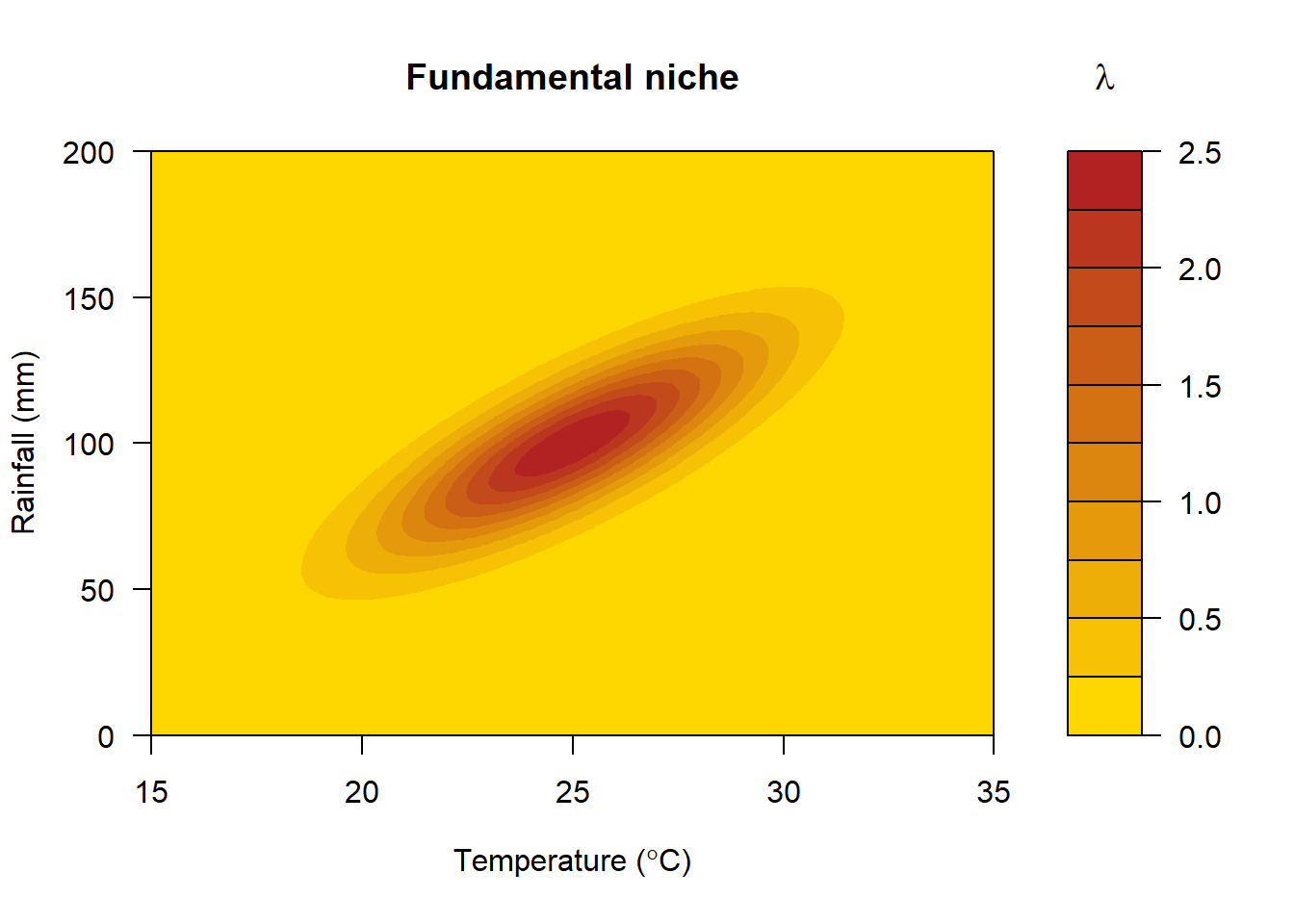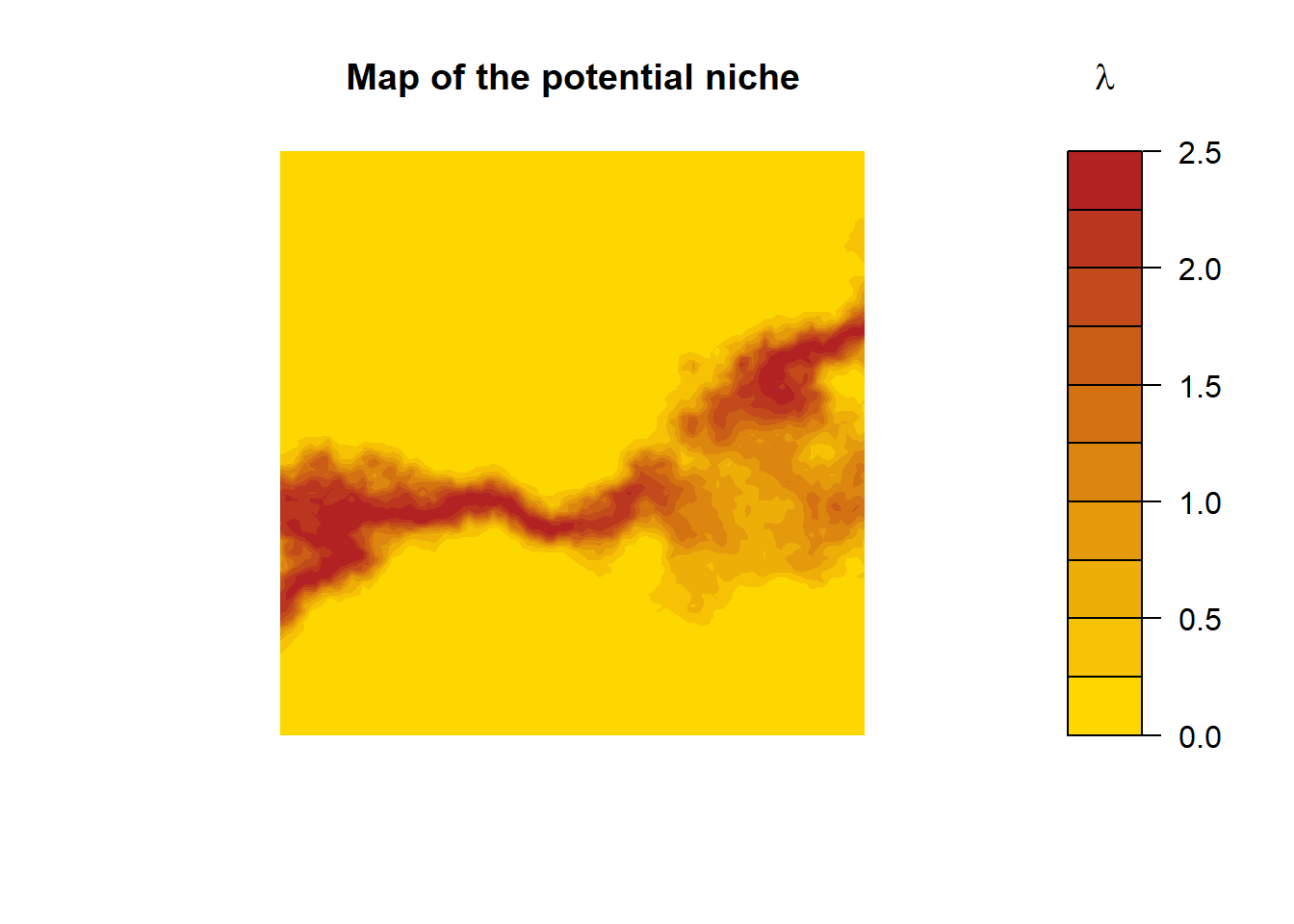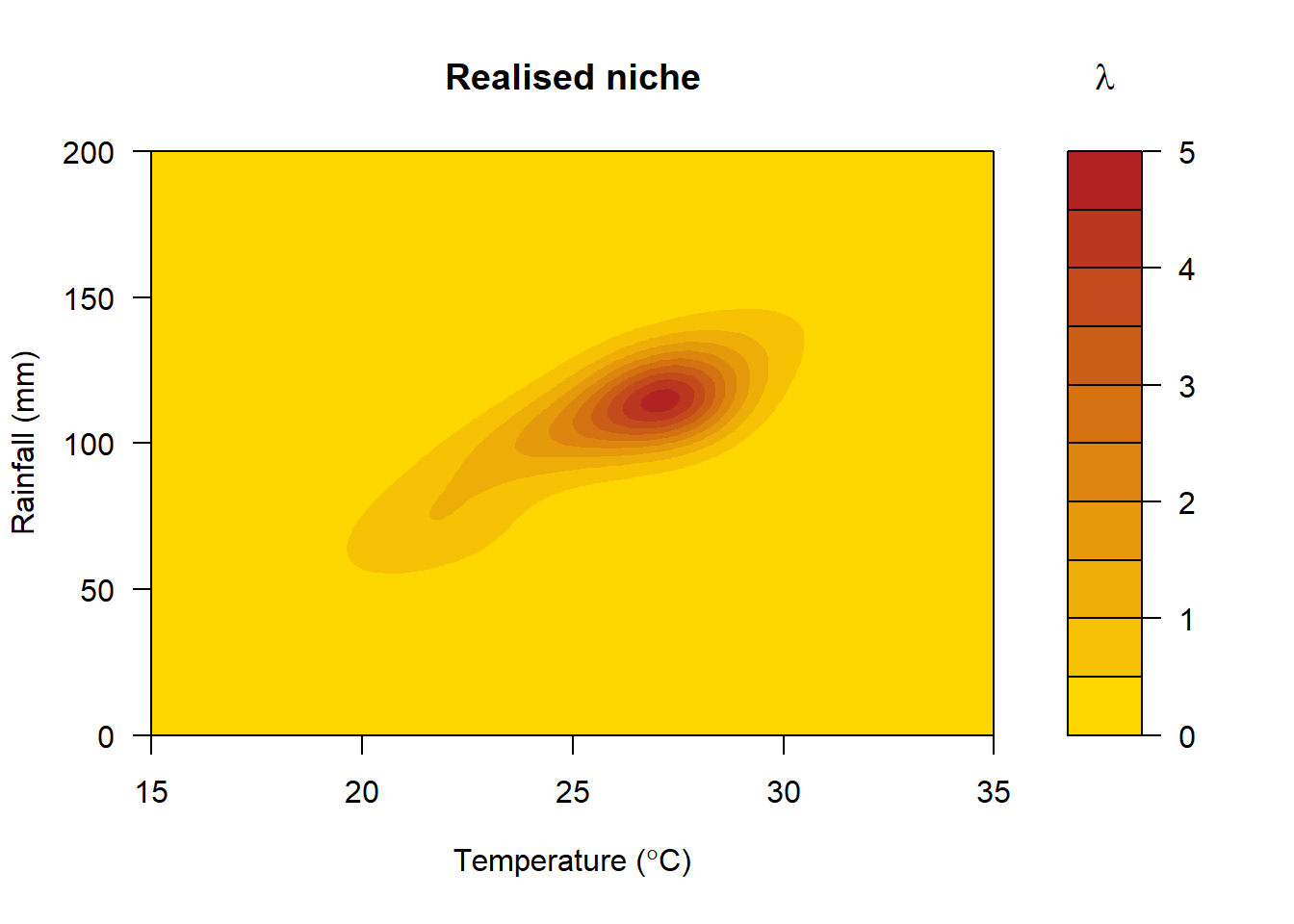To evaluate how well species-environment models perform in different situations, modellers need the ability to generate virtual niches that have known properties. These virtual niches can then form the basis of virtual ecology experiments that can test how well different models perform under different conditions.
virtualNicheR is an R package that is unique in that it provides an
integrated framework that is needed to generate both fundamental and
realised niches. We
envisage that the ability to generate integrated fundamental and
realised virtual niches will allow modellers to improve the virtual
ecology experiments that have been advocated for evaluating
species-environment relationship models.
The fundamental niches are defined as multivariate normal
distributions,
and the realised niches are created by defining the positive and
negative interactions amongst a community of fundamental niches. A full
description of the virtualNicheR package, including connections to
niche theory and an explanation of the underlying mathematics, can be
found in the associated software
paper. While the
examples used here are only for 2-dimensions, virtualNicheR will work
in n-dimensions, and for those interseted in learning more about n
>2 applications we would refer you to the virtualNicheR wiki for a
3-dimensional
example.
If you use virtualNicheR in your research we would be very grateful if
you could please cite the software using the following software paper:
We very much welcome input from others! If you find a bug, need some help, or can think of some extra functionality that would be useful, please raise an issue. Better still, please feel free to fork the project and raise a pull request if you think and can fix a bug, clarify the documentation, or improve the functionality yourself.
You can install virtualNicheR directly from GitHub with either:
# install.packages("githubinstall")
githubinstall::githubinstall("manaakiwhenua/virtualNicheR")
# install.packages("devtools")
devtools::install_github("manaakiwhenua/virtualNicheR")virtualNicheR is not dependant on any additional packages, and was
developed using R version 3.5.1.
In virtualNicheR the fundamental niche of a virtual species S is
defined by:
- λmax, the species’ maximum finite rate of increase at the fundamental niche optimum,
- μ, a vector of means that gives the optimum location of the niche in each dimension, and
- Σ, a variance-covariance matrix that gives the size and orientation of the niche in each dimension.
By generating a systematic grid of coordinates in niche space, the niche can be easily visualised.
library(virtualNicheR)
# Create coordinates across niche space
niche.XY = niche.grid.coords(mins=c(15,0), maxs=c(35,200), nCoords=121)
# Define a species as a function of the maximum finite rate of increase,
# a means vector, and covariance matrix
lambdaMax = 2.5
meansVector = matrix(c(25, 100))
covarMatrix = matrix(data=c(9, 60,
60, 625), nrow=2, ncol=2, byrow = TRUE)
species = list(lambdaMax, meansVector, covarMatrix)
# Calculate the fundamental niche
fundNiche = fund.niche(niche.XY, species)
# Plot the fundamental niche
fundNicheMatrix = matrix(fundNiche, nrow=length(unique(niche.XY[,1])))
nContour = 10
filled.contour(unique(niche.XY[,1]), unique(niche.XY[,2]), fundNicheMatrix,
levels = seq(0, lambdaMax, lambdaMax/nContour),
col=colorRampPalette(c("gold", "firebrick"))(nContour),
xlab=expression(paste("Temperature (", degree, "C)")),
ylab="Rainfall (mm)",
main ="Fundamental niche",
key.title = title(main = expression(lambda)))Given maps of environmental data, the fundamental niche can also be mapped in geographic space to create a potential niche.
# Map the potential niche given maps of environmental variables
# Convert matrices of variables into columns
temp1D = matrix(temperatureMap, ncol=1)
rain1D = matrix(rainfallMap, ncol=1)
data.XY = cbind(temp1D, rain1D)
# Calculate the potential niche and form back in a 2D map
poteNiche = fund.niche(data.XY, species)
poteNiche2D = matrix(poteNiche, ncol=100)
filled.contour(z=poteNiche2D,
levels = seq(0, lambdaMax, lambdaMax/nContour),
col=colorRampPalette(c("gold", "firebrick"))(nContour),
asp=1, plot.axes = {}, frame.plot=FALSE,
main ="Map of the potential niche",
key.title = title(main = expression(lambda)))Having created fundamental niches for several species, by defining a matrix that quantifies the interactions (competition, predation, commensalism, amensalism, or mutualism) between species, it is also possible to calculate a realised niche that accounts for positive and negative affects of species interactions.
# Define the community
species1 = list(2.5, matrix(c(25, 100)), matrix(data=c(9, 60,
60, 625), nrow=2, ncol=2, byrow=TRUE))
species2 = list(5.0, matrix(c(28, 110)), matrix(data=c(4, -20,
-20, 500), nrow=2, ncol=2, byrow=TRUE))
species3 = list(3.0, matrix(c(25, 80)), matrix(data=c(4, 0,
0, 150), nrow=2, ncol=2, byrow=TRUE))
community = list(species1, species2, species3)
# Define the interactions
interactions = matrix(data=c(0.0, 0.2,-0.4,
-1.0, 0.0,-1.0,
-0.6, 0.3, 0.0), nrow=3, ncol=3,byrow = TRUE)
# Calculate the realised niche values
niche.XY = niche.grid.coords(mins=c(15,0), maxs=c(35,200), nCoords=121)
realNiche = real.niche(niche.XY, community, interactions)
# Plot the realised niche for species 1
realNiche1 = matrix(realNiche[,1], nrow=length(unique(niche.XY[,1])))
nContour = 10
filled.contour(unique(niche.XY[,1]), unique(niche.XY[,2]), realNiche1,
levels = seq(0, 5, 5/nContour),
col=colorRampPalette(c("gold", "firebrick"))(nContour),
xlab=expression(paste("Temperature (", degree, "C)")),
ylab="Rainfall (mm)",
main ="Realised niche",
key.title = title(main = expression(lambda)))


